The British gunmaking concern known as Webley & Scott Ltd. started with a young gunmaker's apprentice, Philip Webley. He, along with most other future managers of his company, started their careers the hard way, making, fitting and filing on gunparts and building guns by hand. This may not be a practical path to being a CEO today, but then it was the normal way. He joined his brother, James, in 1835 to start a gun implement and tool business in Birmingham, home to so many other gunmaking companies. By 1840 Philip was already supplying the Government Board of Ordnance and the East India Company with gun parts and tools.
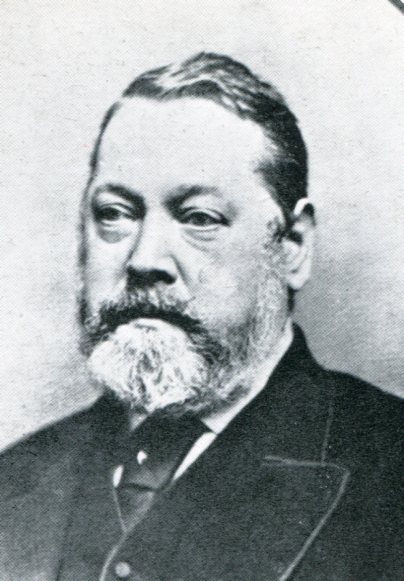
In 1845, Philip bought out the bullet mould and gun accessory business of William Davis, whose daughter, Caroline, he married in 1838. William Davis was a respected gun parts maker in Birmingham, and was even present at the Battle of Waterloo. Philip Webley set up shop at 84 Weaman Street, in Birmingham, which eventually grows and occupies most of the surrounding area. Philip's sons, Thomas and Henry, eventually join and inherit the business.
By 1853, Philip and his brother were making percussion revolvers, but competing with Colt was tough, who had a factory in London making revolvers using mass production techniques. The Webleys could see the writing on the wall. Building guns by hand just wouldn't do any longer. There wasn't a problem with quality, as Webley's guns could be compared to the best, they just couldn't make them fast enough by hand. There was also the problem of interchangeable parts, a new concept that was quickly taking root. The good thing was that the solution took care of both problems, making guns by machine using mass production techniques enabled making all parts identical. Doing it without machines had been done, but couldn't realize the output needed for success. Trying to modernize their machinery like Enfield and Mauser had done using American machinery didn't work out, and Philip and his son T.W. made a gutsy move having the machinery locally made, which turned out well for them and for Birmingham. By 1887, Webley's guns were cranked out by machine and soon the British Government adopted Webley's revolvers as the handgun of the British Empire.
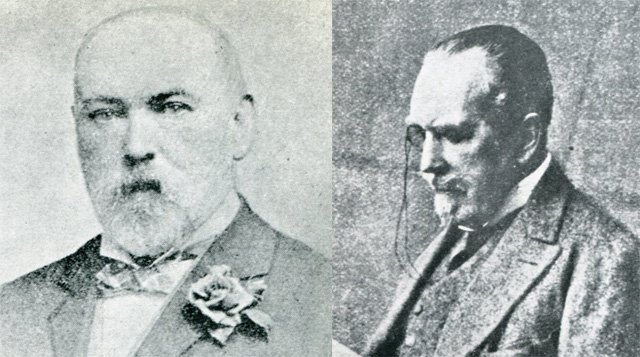
In 1888 Philip Webley died, and his sons took over the Webley concern. Soon, the company put the Webley name on all their revolvers, as some lesser competitors were passing their guns off as Webleys, leading to consumer complaints. By 1893 the company was expanding, with an exhibit at the Chicago Worlds Fair, and addresses in the London area.
The Webley concern went public in 1897, joining with W & C Scott and Sons and Richard Ellis & Sons to form The Webley & Scott Revolver & Arms Co. Ltd. of Birmingham and 78 Shaftsbury Ave. London. W & C Scott & Sons was started in 1834 by William Scott on Weaman Street, and eventually moved to Lancaster Street in Birmingham where they had built the Premier Gun Works, in which they manufactured upper end shotguns. Philip Webley's son Henry retired after the deal was done.
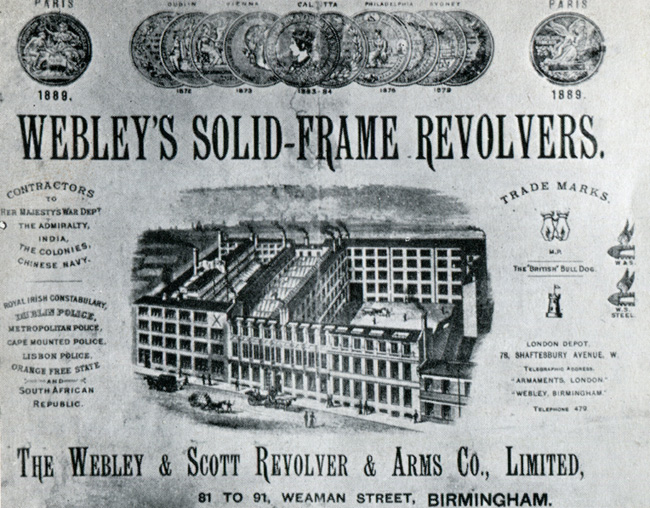
In 1901, Webley's push into the asian market was stopped cold by the Boxer Rebellion. After five years of development, the Webley-Fosbery Automatic Revolver was introduced. There was a flap concerning the Royal Irish Constabulary revolvers in 1902, as a pair of arresting officers had their guns fail to fire, but it was found later that the guns and the ammunition was at least 30 years old. Mr. Thomas W Webley died in 1904. He was apprenticed by the age of eleven, and manager at Webley by the time he was 20 years old. He was 65 when he died, and had remarked at one time that the gun business had made him an old man before his time. By 1905 the gun business went sour, the Boer War had ended, and Webley was scrambling to sell guns.
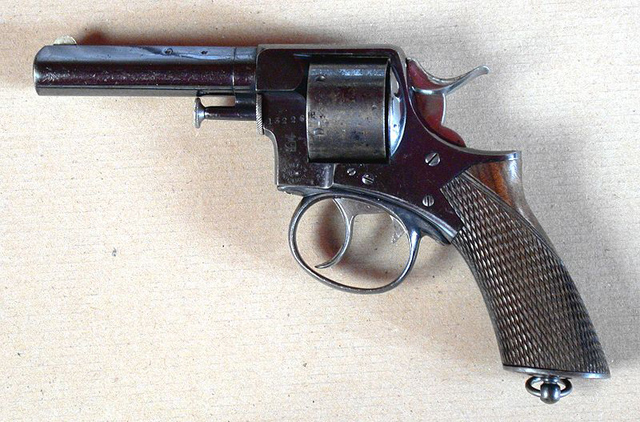
Webley & Scott Ltd.
By 1906, the company changed it's name and made more guns than any other English gunmaking concern. Guns start to sell again by 1909 and all the Webley factories now specialize in their own guns. Revolvers are made at Weaman Street, shotguns are made at Scott's factory, the Premier Works in Lancaster Street. and shotguns at the Ellis concern. During this time, up to the Great War, Webley revolvers were taking honors at the shooting matches in England, specifically the NRA matches at Bisley. The company had developed automatic pistols, and after the Sydney Street Outrage a .32 model was adopted by the London Police departments among others.
During WW1, the Navy and Royal Flying Corps accepted the Webley .455 automatic pistol, and the Army took every revolver Webley could make. They had an open contract for 2500 revolvers a week, and before the war was over, Webley had sold 310,000 revolvers. They made other things as well, among which were almost 200,000 Very Signal Pistols. Henry Webley, retired and in poor health, came back to the company to help out the war effort, his service to the company being invaluable, and he died by 1920. Also during the war, the founder of W & C Scott & Sons died at 81 years, and his factory turned to war production instead of shotguns.
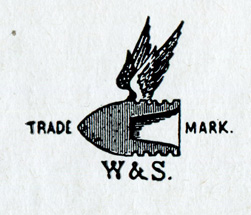
After the war, Webley's fortunes with the British Government started their long decline. The Government still wanted Mk. VI revolvers, they just didn't want to pay much for them. Webley was forced to take less, and it appears that the Government just had Enfield build the Mk. VI without permission. The 1920 Firearms Act in Britain dealt another blow to the firm's bottom line by taking away the right for citizens to own arms, and making it a privilege. In 1922, the War Office wanted a .38 caliber revolver to replace the Mk VI, and had the company work up a new design. In another blow to the company, the British Government had Enfield build it. Webley kept their design common with Enfield's until 1929, but departed slightly thereafter when the War Office lost interest. By 1939, the War Office was interested again and they took all the .38 revolvers Webley could make, even though there wasn't much parts commonality between their revolver and Enfield's. After all, there was a war on.
Webley ran out of room at Weaman Street to ramp up for war production and they had to expand into other factories in the surrounding area, which was also a benefit in the event of air raids. Factories were built at Stourbridge, Selly Oak, Great Barr and the offices moved to Rednal.
In 1957, the War Office decided that it's time for a self loading handgun for the military, and Webley submits their design, but the Government quickly adopts the 9mm Browning as the standard sidearm. It is the end of Webley's involvement with the British Government.
Soon after the Webley & Scott factory on Weaman Street was demolished for the Birmingham Ring Road, and they moved to the suburbs in Handsworth outside of Birmingham. The historic Weaman Street area was the home of the giants of the Birmingham gun trade over the last couple of hundred years, but progress marches on. During the 19th century, Webley had built revolvers and automatic pistols in almost every conceivable combination. They copied other designs also, most likely under license or after the patent's had expired, but tried everything looking for the perfect revolver, which they arguably did build, the hinged frame Mk VI. The new Webley & Scott is not the revolver powerhouse it once was, but the company is still at it doing what it does best, which is making guns. They have quite a line of quality made shotguns and airguns


